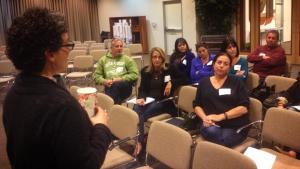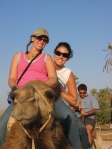 |
| Michelle and family at Eisner Camp |
Twenty years ago, I walked in to my first Religious School teaching
job. I had just finished an amazing summer as a camp counselor at URJ
Camp Swig and was filled with ideas. On that first day of school I
covered the walls with giant posters of text, created a massive pair of
sunglasses hanging from the ceiling, handed out black ray-ban
knock-offs, and challenged my students to “wear their sunglasses at
night” as they went on a scavenger hunt by flashlight to uncover how the
Torah could “shine light” on their daily lives.
During that school
year I would use every programming technique that I had learned at camp –
basketball games with changed rules to explore Jewish leadership
styles, group art work to imagine modernized Torah scrolls, and wrap-up
discussions around fake camp fires. My students enjoyed themselves and
learned, as did I. But in the end, I couldn’t help but feel that I was
missing something. Despite integrating the best informal and
experiential education models that I knew, in the end it was
just religious school. A good year for everyone – but still just a better-than-average isolated year of supplemental education.
In my professional life now as a Jewish Camp Consultant I am often
asked how to bring the magic of camp in to schools and synagogues.
Indeed, recent articles on
ejewishphilanthropy.com,
jesna.org,
and other blog rolls suggest that this is a “hot topic.” When people
ask this question, they often share with me stories much like my own –
stories of bringing in the best experiential programming, but still
falling short of the life-impacting outcomes that they crave. Despite
bringing in the program, the “magic” is missing.
When we began the
Foundation for Jewish Camp Specialty Camp Incubator,
Adam Weiss (Cohort 1 Project Director) and I talked a lot about the
magic of camp. Indeed, we had a unique opportunity to work with camp
directors to create new cultures and new camps. To be successful, the
Specialty Camps needed to intertwine high level specialty education with
Jewish celebration and learning in a seamless synergistic
relationship. In order to support them in this task, we needed to
break down, articulate and plan what was usually accepted as just the
“magic” of the camp experience.
As we worked with the Incubator camps, we realized that there was a
continuum of strategies at play. On one end of the continuum was what we
came to call “Surface Strategies.” Surface Strategies refer to the
planned camp activities that campers and staff organize. Activities
that fall on this end of the continuum have overt goals and occur at a
scheduled time of the day or week. These activities can be isolated,
one-shot programs, or “linked curriculum” with ongoing activities that
occur regularly and seek to foster accumulated knowledge or developing
skill. When driven by outcomes and meaningful content, Surface
Strategies can be powerful tools for building Jewish identity and
knowledge. They can and often do utilize the best of experiential
education – they are active, learner centered, have opportunities for
growth and challenge the campers. These Surface Strategies are
relatively easy to integrate in to synagogue settings and are often held
up as the model when schools try to be “more like camp.” Indeed, it is
this type of programming that I introduced in my first classroom, and
that many have referred to in their articles and blogs.
However, when we stop at Surface Strategies, we miss the other end of
the continuum that camp people know is where the “real magic” lays –
Embedded Strategies. Activities on this end of the continuum are not
on the daily schedule, but lie below the surface of camp and define the
camp environment and experience. When utilized with intentionality,
like Surface Strategies, Embedded Strategies are powerful tools for
forming identity. Indeed, without them, camp loses its impact.
Strategies on this end of the continuum include intentional role
modeling, relationship building, rituals, utilizing Jewish teachable
moments,
aspirational arcs and creating sacred spaces. Making
schools more like camp is not just about integrating experiential
education techniques (though these are important), it is about wielding
the power of Embedded Strategies and taking advantage of every asset
camp offers, to create communities where Judaism is a living, vibrant
reality.
At intentionally crafted camps, counselors are prepared not to just
teach, but to create meaningful relationships with their campers and
fellow staff members. They are told the importance of getting to know
the kids, and are encouraged to share their love and excitement for
Judaism casually throughout the day. Campers are told that camp is a
place you make “life-long friends,” and the entire institution supports
this goal. Rituals are intentionally crafted to touch souls, and frame
days and weeks. The Dining Hall is the
Chadar Ochel, and
Hebrew becomes the “secret language” of camp. Campers know that when
they come back every year they will have more privileges and
responsibilities, from later bedtimes to running Maccabiah. Staff tell
campers that they are “being a
mensch,” and “showing
kavod”
when they help a friend, and everyone cries while they pack their bags
and head home. These Embedded Strategies don’t happen by chance – they
are intentionally crafted, outcome focused, and reinforced in staff
development and daily decisions.
If we truly hope to learn from camp how to create synagogues and
school based education programs that impact lives, than we need to
utilize the entire continuum of intentional strategies. We need to go
beyond just program, and ask ourselves questions such as:
- Who do we hire to work in our congregations and schools and how do
support them in building relationships, being role models, and sharing
their own Jewish journeys?
- What rituals do we craft that frame the experience and are impactful, relevant and engaging?
- How do we foster a community that views Jewish learning and celebration as positive, meaningful, and on-going?
- How do we build aspirational arcs where students and adults
see the potential for growth with expanding learning opportunities,
privileges and responsibilities?
- What unique assets do schools and congregations have and how can we leverage these assets to impact Jewish identity building?
From Family Education tracks to hybrid Daycare/Hebrew Schools, new
models of supplemental education are emerging across the Jewish world.
Though these new models and approaches are exciting and hold great
potential – they are no more or less powerful than trees, lakes and
cabins. What creates “summers that last a lifetime” isn’t just the
setting or program model. Summers that last a lifetime are
intentionally crafted below the surface, cultivating magic, interaction
by interaction.
Ray-ban knock-offs, however, are always helpful.






